Sharing photos online is a regular part of our daily lives, whether for personal use, professional portfolios, or social media. However, the convenience of online sharing comes with the risk of unauthorized use or theft. To keep control of your content, it’s essential to understand how to secure photos effectively.
Understanding the Risks of Sharing Photos Online
When you post photos online, they can be easily copied, shared, or even altered without your permission. Although you may trust the people in your network, the vast nature of the internet makes it challenging to control where your images end up. Hackers, scammers, and even companies can misuse photos for identity theft, fraudulent advertisements, or other unauthorized purposes. This is why securing pictures is critical. For an insightful guide on protecting photos, check out this article from Norton.
Steps to Secure Photos from Misuse
Choose Secure Platforms
Where you upload your photos matters, so use platforms with substantial privacy and security features. Each website and social media platform has different policies for content usage, so it’s essential to review their terms before sharing. To keep your images safe, go for platforms that prioritize encryption and secure photos.
Adjust Privacy Settings
Most platforms allow you to control who can view, comment on, or share your content. Adjust your privacy settings to limit access to your images. If you don’t want your pictures publicly visible, ensure your private profile and only trusted contacts can see your photos. For tips on securing your social media profiles, review Facebook’s privacy guide.
Watermark Your Photos
A watermark adds an extra layer of protection to your photos. You deter others from stealing or misusing your images by embedding a watermark with your name, brand, or logo. Numerous free and paid tools are available to create custom watermarks for your photos.
Use Digital Rights Management Tools
Digital Rights Management (DRM) tools are handy for professionals looking to secure photos. These tools allow you to control how others interact with your images by limiting sharing, downloading, or copying. Many photographers and content creators rely on DRM tools to protect their intellectual property.
Be Cautious with Metadata
Photos typically include metadata, such as the time and location of when and where they were taken. Before sharing, especially publicly, it’s a good idea to remove this information. Tools like ExifTool allow you to edit or remove metadata from your photos before posting them online.
Monitor for Misuse
Use reverse image search tools like Google Images or TinEye to protect your secure photos. These tools help you find unauthorized uses of your pictures so you can take appropriate action. Use TinEye’s reverse image search tool to track where your images are being used.
Know Your Rights
As the creator of a photo, you automatically own the copyright to it. You can file a copyright infringement claim if someone misuses your image without permission. Understanding local copyright laws ensures you’re better prepared to protect your secure photos and know when to take legal action. For more information on copyright protection, visit Copyright.gov.
If you discover that your photos have been misused despite your precautions, here are the steps you can take:
- Contact the website or platform: Most social media platforms and websites have reporting systems for stolen or misused content. Request that your image be removed by filing a complaint.
- Send a cease-and-desist letter: For more severe cases, such as unauthorized use in advertisements, you can send a cease-and-desist letter to the party responsible.
- Seek legal advice: In cases of significant financial or reputational damage, it may be necessary to consult a lawyer and take legal action.
What to Do if Your Photos Are Misused
The Importance of Educating Others
Educating others about securing photos is as important as protecting your images. Many people unknowingly leave themselves vulnerable by sharing photos without proper security measures. Sharing your knowledge about privacy settings, watermarking, and photo rights can help build a safer online environment for everyone.
Securing your photos online requires both vigilance and the use of available tools. You can better protect your images from unauthorized use by choosing the right platforms, adjusting your privacy settings, adding watermarks, and staying informed about your rights. Make securing photos a priority whenever you upload images, ensuring they remain safe in the digital world.
Interested in learning more? Take a look at our courses.




